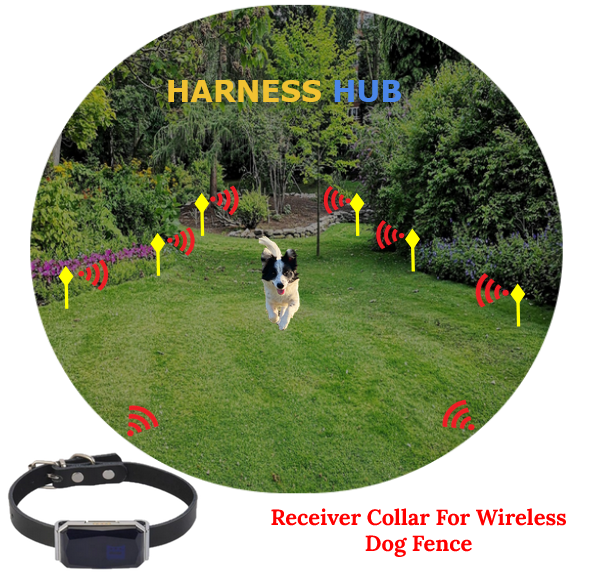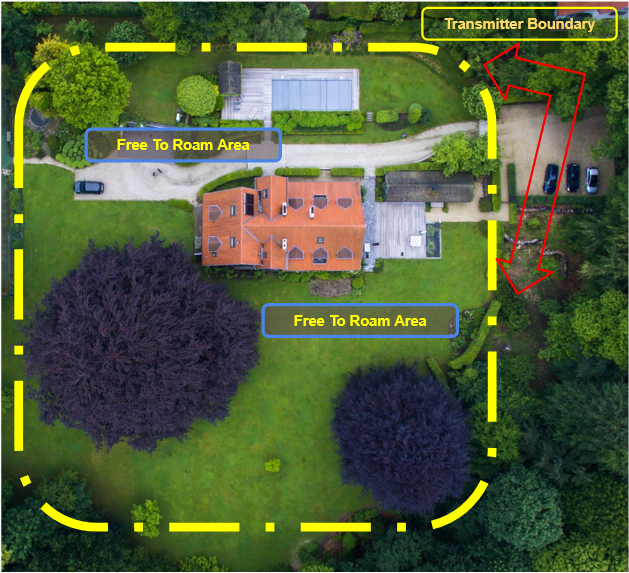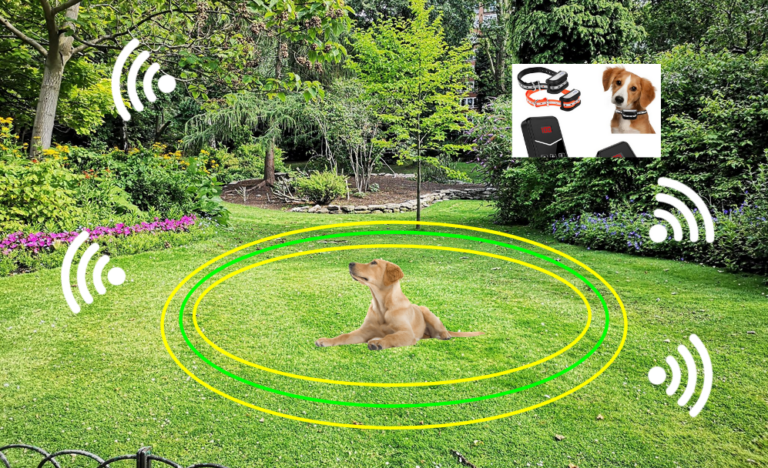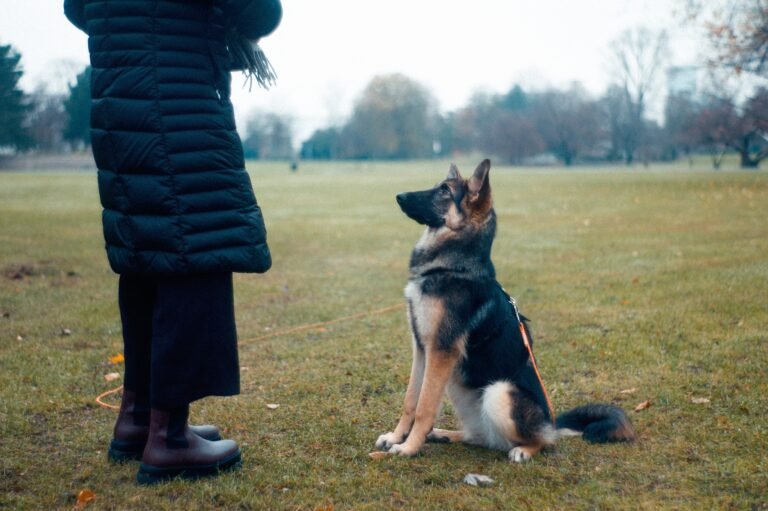
Are you a pet parent of a stubborn dog? Is your dog a classic runaway who quickly disappears when he sees something exciting or smells game? If so, then the wireless dog fence is the right choice for him and also for you.
Owning a dog is a fulfilling experience but being a pet parent comes with a lot of responsibility. One of the most crucial challenges is keeping dogs contained when they’re outdoors, especially if they’re escape artists or stubborn. We have come up with a comprehensive guide that includes everything you need to consider when choosing a wireless dog fence. We will get started:
Overview of Article show
What Is a Wireless Dog Fence?
Undeniably a wireless dog fence is the perfect solution if you want to give your dog plenty of freedom to play and explore while keeping him safe. The fencing system consists of two separate components that are designed to work together: the transmitter and the receiver collar.
Wireless dog fences feature a number of convenient advantages for you and your furry companions:
- They’re quick and easy to set up. You can easily have a wireless fence up and running in almost an hour.
- Very low maintenance. With no wire to bury underground, you don’t need to work about wire breaks or replacing your wire.
- Entirely portable. You can take the wireless fence system with you wherever you go. You can use them to create a safe space for your furry companion anywhere, anytime.
- As they’re invisible, a wireless fence system will not damage the beauty of your property.
How Does a Wireless Dog Fence Work?

By having a wireless dog fence it allows your pet to roam a designated area of the yard without being bound by a leash. The system utilizes the combination of one, or more, transmitters and a receiver worn on the pup’s collar. This transmitter emits signals that create an invisible perimeter around your home.
It is the transmitter component that determines how much area a wireless dog fence can cover. The transmitter emit signals that create an invisible perimeter around your home. The transmitter is in constant contact with the receiver collar.
Wireless dog fences work by giving your dog a warning beep as he nears the boundary created by the transmitter. It gives him a slight shock via his receiver collar if he continues to move beyond the designated perimeter after hearing the beep.
Soon the dog learns to stop when he hears the warning to avoid the shock. The shock should only be strong enough to startle the dog and not enough to cause real pain.
What To Look For in a Wireless Dog Fence System
A wireless dog fence is a great solution for pet parents who want to restrict their dog’s access to a particular area of the yard. Also, many dog owners with large yards prefer a wireless fence instead of traditional fencing to avoid enclosing the entire lot.
There are many different wireless dog fences on the market, each offering unique features. Before getting a wireless dog fence, consider the following aspects:
1. How Much Area Do You Want to Cover - Perimeter Size
Depending on your yard size, you should choose a wireless dog fence that covers a large enough area. Basically the space should be large enough for your dog to run around and exercise freely. Generally enough open space will prevent them from feeling distressed and stop causing havoc inside your home.
Assessing the perimeter size will also determine the type of system you choose, specifically the technical aspects and range of the transmitter and receiver-collar.
2. Installation Requirements and Difficulty
Obviously the installation process of a wireless dog fence system varies depending on your personal preferences and your individual needs. Once you’ve decided on a wireless dog fence, you should determine if the company you purchased from will do the installation or if it is something you will be doing on your own.
Ensure you read the entire manual and contact the manufacturer or dealer with any questions you may have prior to installation. Some wireless fence companies will not only install the system but will even assist with the initial pet training. In this situation, it will help the pet with getting used to how the fence works.

3. How Many Dogs Will Be Sharing the Space
The more dogs you have in the wireless fence system, the more perimeter space you are likely to need. This means that you have to purchase a system with a transmitter that can create a large enough boundary. You may be required to purchase a system with multiple transmitters to create the larger perimeter.
You need to ensure the wireless fence you buy can accommodate all your dogs. Usually, there’s no limit to the number of dogs you can have in the wireless fence system. You also need individual receiver collars for each dog that you own. Just make sure you get compatible collars for your specific wireless system for all your dogs.
4. What Is the Maintenance Requirements
Like most electronic items, wireless dog fences have ongoing maintenance. In short, routine maintenance of the receiver collar includes recharging batteries, replacing batteries, cleaning metal contact points on the receiver unit, etc. However, the time and effort you spend maintaining your wireless dog fence is a small price to pay for the flexibility it offers you.

5. How Much Does the Wireless System Cost
There’s a lot of variety when it comes to wireless dog fence systems and that means a lot of variation of prices. Investing in a good wireless dog fence system saves you a lot of money in the long run.
The cost of wireless dog fences varies depending on a lot of things. This includes things that come in the kit and items you need to purchase separately — like additional collars or transmitters. What’s important is that you take the time to look around and compare the price and the features. Furthermore, do your homework and figure out which one is the best system for your needs and your pet’s comfort and safety.
Important Features Of the Receiver Collar
Generally the wireless dog fence system consists of the wireless transmitter and the receiver collar. The receiver collar is placed on your dog and they emit a high-frequency audible noise when the dog get close to transmitter’s perimeter. If dogs ignore this warning and proceed further, they’ll receive a small zap through the collar. Here are some aspects to keep in mind when comparing dog receiver collars:
Waterproof feature:
Basically waterproofing allows the collar to get wet or submerged for prolonged lengths of time. This means that it’s okay to get the collar wet if your dog is out in the rain. Most receiver collars may get damaged if submerged or gets wet for a longer length of time.
Durability:
When selecting a wireless dog fence system, durability is key. Only you know how large your dog is and how rough he likes to play. For the most part the receiver collar should safely withstand daily usage and challenging weather conditions. Take durability into consideration when comparing one wireless fence system to another.
Rechargeable vs disposable batteries:
Another thing to consider is rechargeable vs. disposable battery units. When dealing with rechargeable batteries you want to make sure you ask the seller or check the specs to see how often the collar needs to be recharged. Also, take into consideration how long it takes to recharge and whether the charger is included with the fence kit or not.
Adjustable static correction:
Whether your dog is small or big, obedient or stubborn, you will need to adjust the intensity level of their static correction. In fact, static correction is what every receiver collar of the wireless dog fence system utilizes to train the dog. So the level of static correction should be adjustable and beeps to help familiarize your dog with their new boundaries.
Safety time-out:
Most receiver collars have some type of built-in safety time-out. It’ll ensure your dog never receives electric stimulation for longer than a set amount of time.
Battery backup:
Typically the dog fence is powered by electricity, so it won’t function during a power outage. Therefore the wireless fence transmitter will need to be plugged into a standard outlet to work. To prevent it from failing, you may want to consider a wireless dog fence system that has a battery backup – so you won’t find your dog halfway down the street one morning when the main power is out.
How To Install a Wireless Dog Fence System

Although installing a wireless fence for your dog is very simple and easy. Keep in mind that the exact installation method will likely differ slightly from one brand to another, but the basic concept will always remain the same.
1. Find a location for your transmitter:
The first installation step is finding the right location to place your wireless dog fence transmitter. Consequently the installation spot will determine your pet zone, which means the exact location of your containment area. Wherever the transmitter goes it will mark the center for the pet zone. There needs to be a power outlet close to the location for the transmitter. It should be on your ground floor, between 3 & 5 feet off the ground.
2. Activate the signal receiver collar:
To activate the signal receiver collar, you need to insert a working battery first. Once a battery is inserted you will turn the collar on. In some cases you may need to register the collar first.
3. Set the radius of your containment area:
The maximum radius you can set for any wireless dog fence will be anywhere between 90 and 250 feet. The actual procedure for setting the radius will depend on the model of your wireless dog fence.
This step is usually carried out by two people. One person stays in the yard with the receiver collar while the other person starts changing the radius until the receiver collar starts beeping. The two people should be communicating with each other while adjusting the radius setting. However, if done properly this will ensure the optimal radius setting is achieved.
4. Setting the correction level:
Generally the strength of the wireless fence can be adjusted by changing the shock level of the dog’s receiver collar. Setting the correction level depends on the wireless fence system model you buy. Every dog is different, so determining and setting the right correction level setting is an individual process.
5. Plant the training flags:
Finally plant the training flags. Take the receiver collar in your hand and slowly approach the zone boundary. Once you hear the collar’s beep, stop moving and plant one flag right in front of your feet. Basically repeat these steps again across the length of the circumference of the entire boundary. You should plant the flags at a space around 7 – 10 feet away from each other. This step can take up to 15 minutes.
Training Your Dog Using the Wireless Dog Fence

You can begin to train your dog to respect the wireless boundaries once you’ve got the entire wireless dog fence system installed. Unless you have had a wireless dog fence system installed previously, it’s going to be a whole new experience for your furry pal.
Training your dog using a wireless dog fence is exciting but at the same time, it’s challenging. Undoubtedly the training time for wireless dog fences depends on the size of the area, age and breed of dog.
The following steps are commonly used when training a dog with the wireless fence system:
Introducing Your Dog To the Boundary:
First step of the training involves introducing your dog to the defined boundaries and teaching him to respect them and retreat when required. Depending on your dog’s temperament, the boundary introduction should last for 5 to 7 days. Split up the daily training regimen into 3 training sessions, 15 minutes each.
Static Correction Training:
Introduce static correction to make your dog aware that there is something unpleasant involved if they attempt to cross the boundary. The static correction training should last 1 week, regardless of your dog’s temperament and size. Choose the right static correction level available in your wireless fence receiver collar. Put the receiver collar around your dog’s neck ensuring that it is not too tight. If your dog doesn’t respect the boundary after a week of training, extend the training phase by an extra 3 – 7 days.
Distraction Training:
There are always distractions outdoors, such as squirrels, kids, or other dogs. Distraction training is aimed at fixing daily distractions which will get your dog excited. Once your dog is familiarized with the containment area and static corrections, continue your dog training by testing for distractions. However, only train one pet at a time to avoid unnecessary distractions.
Off-Leash Supervision:
Once your furry companion knows the boundaries of his yard and ignores distractions, he’s ready for more freedom. Allow your dog to enjoy the yard off-leash but still wearing the receiver collar as you do something close by. Start with 20-minute supervised off-leash sessions and keep extending your dog’s off-leash time daily if your dog never goes out of the pet zone.
Remember To Keep It Fun:
Your dog needs to feel relaxed before and after the training session given this type of training can be stressful for your pup.
Pet Parent Tip:
Remember not to train two or more dogs at once. Always devote your full attention to one dog during a single training session.
It is your responsibility to make sure your dog is well-trained. It’s not just important for your dog’s welfare, but for your own comfort and peace of mind as well.
There are numerous videos and experts online that will show you all the best tricks to help train your pet to feel comfortable with the wireless fence. Unquestionably there’s one thing you shouldn’t do, it’s taking off the receiver collar. Taking off the receiver collar is going to interrupt your dog’s training and may cause bad habits.
Best Practices - Helpful Pointers
Follow these helpful pointers to properly secure your yard so your pup can explore their surroundings while staying safe.
- Never place any items including metal or any other material on top of the transmitter. You should make sure that all metal objects are kept at least 3 feet away from the transmitter.
- You must ensure that none of the transmitter’s ventilation openings are blocked by any household items.
- Do not use thinners, petrol, or volatile substances to clean the wireless dog fence.
- Water can cause irreparable damage to the transmitter. The transmitting generator isn’t waterproof, so use with caution in wet environments.
- It’s best to replace the rubber seal in the receiver cap once a year to maintain water tightness.
more:
- If you don’t use the device for a month or more, it’s recommended to remove the batteries.
- Make sure the receiver collar is fit properly, not too tight or too loose. As long as you can fit a finger between your dog’s skin and the probes you are fine.
- Wireless dog fences may not be suitable for narrow properties or for sloping or terraced gardens. Also, heavily wooded areas can interrupt the signal.
- Keep your wireless fence training sessions short and always end them on a positive note. They should not last more than 15 minutes. All dog training sessions must end on a positive note to reduce stress related to the training.
Conclusion
There’s no doubt that dogs make outstanding pets. If you are a responsible pet parent who appreciates the latest in technological solutions, wireless dog fences are an appropriate choice for you.
It’s an excellent way to keep your dog safe and secure in your yard. Wireless dog fences are quick and easy to set up and maintain. The convenience, safety, and peace of mind are simply hard to beat!


